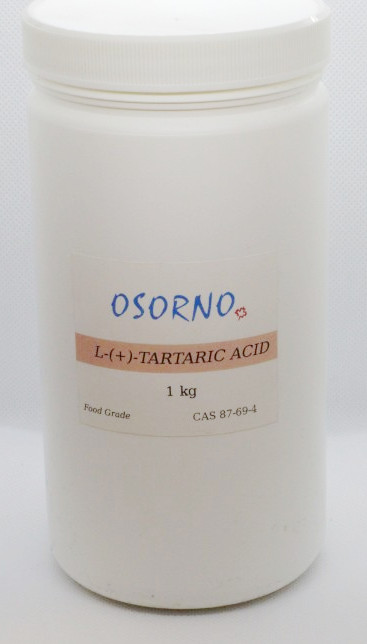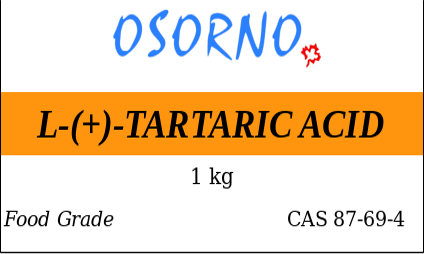Tartaric Acid
Tartaric Acid
A natural fruit acid with a clear and neutral taste, tartaric acid is the main acid in grapes. For this reason, it should be the preferred acid in making fruit wine. Osorno’s tartaric acid comes from Italian wine, and we sell it as a crystalline product in 1 kg jars. To purchase Tartaric Acid, please visit the Osorno Store.
Chemical Information:
- CAS # 87-69-4 (L), 147-71-7 (R), 147-73-9 (meso), 133-37-9 (DL)
- FW 150.09 g/mol
- Solubility 1,394 g/l
- pKa 2.98 (first stage), 4.34 (second stage)
Without any doubt, tartaric acid is the most important acid in winemaking.
Although tartaric acid is abundant in nature, it is still found in small concentrations, with only a few exceptions. Among those exceptions are most notably grapes and a diverse range of plants, including dandelion, tamarind, agave leaves, black pepper, and pineapple.
Tartaric acid is highly soluble in water, but several of its salts, most notably potassium hydrogen tartrate (cream of tartar) and calcium tartrate are insoluble. You can find cream of tartar at the bottom of wine casks, where it forms a whitish crust. This crust can also be found in wine bottles when wine is chilled. To prevent cream of tartar from forming, we advise keeping wine chilled for at least a few weeks before bottling.
The solubility of calcium tartrate is much lower than that of potassium hydrogen tartrate. For all practical purposes, calcium tartrate can be considered completely insoluble. This has far-reaching consequences in winemaking when hard water is used to prepare wine.
On the downside, tartaric acid is irretrievably lost when it is used to remove minerals from hard water, such as calcium and magnesium tartrate. On the upside, the unpleasant hardness of the water is removed this way. It is up to the hobby winemaker to balance one against the other.
Personally, we feel that removing excess calcium and magnesium outweighs the loss of tartaric acid.
In mineral-poor wine (such as mead), adding cream of tartar can noticeably improve the body and mouth-feel. However, it also noticeably increases the wine’s acidity.
It is important to understand that tartaric acid and its salts cannot be used when oxalic acid must be removed. This is because calcium tartrate is even less soluble than calcium oxalate. For this reason, we recommend using calcium lactate to remove oxalic acid.
Tartaric acid is produced worldwide, almost exclusively out of the abundant deposits in wine casks. It is permitted as a food additive in most countries, and roughly 50% of it goes back into the food industry.


